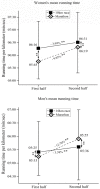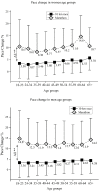Pacing in Long-Distance Running: Sex and Age Differences in 10-km Race and Marathon
- PMID: 33920504
- PMCID: PMC8073231
- DOI: 10.3390/medicina57040389
Pacing in Long-Distance Running: Sex and Age Differences in 10-km Race and Marathon
Abstract
Background and objective: The recent availability of data from mass-participation running events has allowed researchers to examine pacing from the perspective of non-elite distance runners. Based on an extensive analysis of the literature, we concluded that no study utilizing mass-participation events data has ever directly compared pacing in the 10-km race, with other long-distance races. Therefore, the main aim of this study was to assess and compare pacing between 10-km runners and marathoners, in regards to their sex and age. Materials and methods: For the purpose of this study, official results from the Oslo marathon (n = 8828) and 10-km race (n = 16,315) held from 2015 to 2018 were included. Results: Both 10-km runners and marathoners showed positive pacing strategies. Moreover, two-way analysis of variance showed that women were less likely to slow in the marathon than men (9.85% in comparison to 12.70%) however, not in the 10-km race (3.99% in comparison to 3.38%). Finally, pace changing is more prominent in youngest and oldest marathoners comparing to the other age groups (12.55% in comparison to 10.96%). Conclusions: Based on these findings, practitioners should adopt different training programmes for marathoners in comparison to shorter long-distance runners.
Keywords: endurance; health; marathoners; recreation; running.
Conflict of interest statement
The authors declare no conflict of interest.
Figures



Similar articles
-
Age Differences in Pacing in Endurance Running: Comparison between Marathon and Half-MarathonMen and Women.Medicina (Kaunas). 2019 Aug 14;55(8):479. doi: 10.3390/medicina55080479. Medicina (Kaunas). 2019. PMID: 31416198 Free PMC article.
-
How recreational marathon runners hit the wall: A large-scale data analysis of late-race pacing collapse in the marathon.PLoS One. 2021 May 19;16(5):e0251513. doi: 10.1371/journal.pone.0251513. eCollection 2021. PLoS One. 2021. PMID: 34010308 Free PMC article.
-
Elderly female ultra-marathoners reduced the gap to male ultra-marathoners in Swiss running races.Sci Rep. 2023 Aug 2;13(1):12521. doi: 10.1038/s41598-023-39690-6. Sci Rep. 2023. PMID: 37532766 Free PMC article.
-
Pacing profiles and tactical behaviors of elite runners.J Sport Health Sci. 2021 Sep;10(5):537-549. doi: 10.1016/j.jshs.2020.06.011. Epub 2020 Jun 26. J Sport Health Sci. 2021. PMID: 32599344 Free PMC article. Review.
-
Physiology and Pathophysiology in Ultra-Marathon Running.Front Physiol. 2018 Jun 1;9:634. doi: 10.3389/fphys.2018.00634. eCollection 2018. Front Physiol. 2018. PMID: 29910741 Free PMC article. Review.
Cited by
-
The pacing differences in performance levels of marathon and half-marathon runners.Front Psychol. 2023 Dec 21;14:1273451. doi: 10.3389/fpsyg.2023.1273451. eCollection 2023. Front Psychol. 2023. PMID: 38187410 Free PMC article.
-
Pacing in ultra-marathon running: the Western States 100-mile endurance run 2006-2023.Sci Rep. 2025 Mar 15;15(1):8926. doi: 10.1038/s41598-025-92141-2. Sci Rep. 2025. PMID: 40087377 Free PMC article.
-
A preliminary exploration of the regression equation for performance in amateur half-marathon runners: a perspective based on respiratory muscle function.Front Physiol. 2024 Mar 25;15:1340513. doi: 10.3389/fphys.2024.1340513. eCollection 2024. Front Physiol. 2024. PMID: 38590694 Free PMC article.
-
Gender and Age Differences in Performance of Over 70,000 Chinese Finishers in the Half- and Full-Marathon Events.Int J Environ Res Public Health. 2022 Jun 25;19(13):7802. doi: 10.3390/ijerph19137802. Int J Environ Res Public Health. 2022. PMID: 35805460 Free PMC article.
-
The physiology and psychology of negative splits: insights into optimal marathon pacing strategies.Front Physiol. 2025 Jul 16;16:1639816. doi: 10.3389/fphys.2025.1639816. eCollection 2025. Front Physiol. 2025. PMID: 40740427 Free PMC article. Review.
References
MeSH terms
LinkOut - more resources
Full Text Sources
Other Literature Sources

